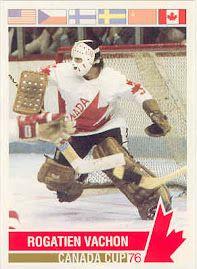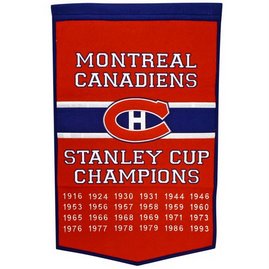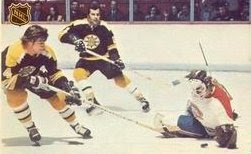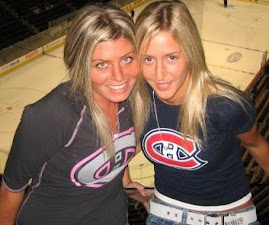


(RC Note: If you check the sidebar on this site you will see a quote from Tapeleg at JAHL regarding the writing quality of bloggers on the internet. I thought of that quote upon reading a piece posted recently at the Leafs Club site written by Wardo. It was an inspiring piece of work that I wholeheartedly disagreed with. That is not a knock on Wardo - one cannot argue with a perspective. His impassioned post, filled with vivid detail, ought to bring out from any hockey fan worth their salt, an equally impassioned opinion. I couldn't help myself actually - this post began writing itself before I was finished reading Wardo's. It hooked me in emotionally, carrying me away, while I succumbed to each notion that baited me to write on. I suggest that before proceeding to read what I have to say on the subject, that you follow this link, read his excellent post, then give mine a going over. Either way you choose, don't skip it and just read this piece below - you would be cheating yourself. Enjoy!)
To delve straight into the subject at hand, the Leafs Club post concerns the long standing tradition of retiring of jersey numbers versus the ideology of honouring them, without taking such treasured numbers out of circulation.
This likely would only concern fans of the original six teams, and possible the first six expansion teams that followed. While Detroit, Chicago, Boston, and the New York Rangers all share long storied histories filled with tradition, this post will simply focus on how the Canadiens and Leafs - the NHL's oldest and most storied clubs - treat the subject.
As you well know, these two teams have proceeded in opposite manners when it comes to the respected jerseys of their greatest players. Toronto chooses to retire only players whose life was lost while donning the blue and white. This would include Ace Bailey ( #6 ) and Bill Barilko ( #5 ). Barilko was immoratalized in that great Tragically Hip song "Fifty Mission Cap", just incase you needed the additional reference. Bailey sadly perished as the result of a violent on ice incident in 1934.
Along with those two numbers, Toronto has chosen to "honour", yet not retire jersey #1 ( goalies Turk Broda and Johnny Bower), #7 ( King Clancy, one of hockey's greatest builders, and Tim Horton, who prior to donut fame, was the Dion Phaneuf of his day), #9 ( Charlie Conacher and Ted Kennedy ), #10 ( Syl Apps and George Kennedy ), and #27 ( Frank Mahovlich and Darryl Sittler).
Missing among the names mentioned above is forward Dave Keon. Keon, in the opinion of many, was perhaps the greatest Leaf of all. In the minds of some, he has been termed the games greatest two way player. Evidence of such claims in is no shortage. Keon was the captain of the last Leafs team to win the Stanley Cup.
He has been omitted from the select honourees because he has refused to set foot in the Air Canada Center, and Maple Leaf Gardens previously, because the organization flatly defends its policy of not retiring jerseys.
I find that it really is a shame.
The subject of jersey retirement has likely been brought to a head as of late with news that Mark Messier's #11 will soon hang in two different arena's and Brett Hull's #16 was recently raised in St. Louis. Other names are sure to follow.
As for the original six depleting the existance of the classic lower numbered jerseys, some fans are of the opinion that enough is enough.
What is likely spurring that sentiment on, are the Montreal Canadiens quest to retire all worthy jersey numbers by 2009, their centennial year.
It began last season when they did double duty on the #12 in the names of Dickie Moore and Yvan Cournoyer. The saddest of days occured when they raised Bernie "Boom Boom" Geoffrion's #5 on the day of his death.
This season they have taken care of Serge Savard's #18, and will do the same for Ken Dryden's #29 on January 29th, 2007.
With the still untouched #19 unadorned since Larry Robinson's heyday, the tricky task of raising Patrick Roy's #33 due to events surrounding his departure from the team, and possibly even Bob Gainey's #23, in tribute to one of the game's best defensive forwards, likely to come in the next two years, many are surely wondering where it all has to end.
It is not an invalid point.
Yet, the Montreal Canadiens are not your usual franchise.
With 24 Stanley Cup championships in their 97 year history, it can easily be defended that of the ten numbers so far raised, all were deserving. Of the three to come, only Gainey's may be arguable as he was not an offensive star, merely a starting point in the NHL's recognition of supreme defensive ability.
Everyone can pick their sticking points. Mine are Al Hamilton's jersey in Edmonton and Bob Nystrom's on Long Island - but that's neither here nor there in reference to the Habs and Leafs.
Savard's turn did elicit some fraying of nerves, yet he was a pilar of 8 Stanley Cup wins, with a Conn Smythe and a Masterton in the bag, not to mention the All-Star teams he was voted onto. Add onto that his achievements as the Habs GM for a dozen plus years and I can understand the organization feelings for the honour bestowed upon him.
Perhaps my point of view comes from having lived throught it all.
I have been a hockey fan since as long as I can remember. When I was almost 7 years old, the name Bobby Orr filtered through my ears, with adjectives attached to him, the lives of which I cannot describe. I sought out all he was. However, there were but two teams our household was able to catch on TV - the Leafs and the Habs.
I watched the Habs take the 1971 Stanley Cup in what was the best final I have ever seen. Still what made me a Habs die hard began happening outside the NHL at the time. My hometown junior hockey team, the Cornwall Royals were playing in the QMJHL. The resident superstar of the league was Guy Lafleur. Lafleur was in the midst of a 130 season, and I swore up and down that where ever he went in the bigs - that would be my team!
No need to recount history here.
The Habs fixation was nurtured by my father. Growing up, I was regalled with tales of the great Habs - Leafs rivalries of my father's youth. I patiently waited to witness it myself. I'm still waiting.
Other than a pair of inconsequential playoff sweeps, I have yet to dearly enjoy a Habs - Leafs playoff tilt in those 36 years I came darn close in 1993 - consolling myself that a Gretzky - Habs final was the second best thing. A distant second!
Along the way, I have maligned the Buds at every turn, resentful of them not showing up annually. Aside from the Canadiens, I have poured over their history, detailed as it is, studying each failing with the same magnifying glass I use for the Habs in good times and bad. It adds up to a "what to do right" and "what to do wrong" perspective.
And that brings me back to the matter of jerseys.
There seems to be the concern of numbers running out. It is focused primarily on the lower, call them classic numbers, if you will. There is also a stigma attached to higher numbers being considering fringe training camp digits.
I understand that, I have felt exactly that way. Watching Patrice Brisebois, whose name ought to be totally alien to this article, wear the typically uncool #43 for over a decade - I get the drift, trust me!
Pick your own player of high numbered irrelevance - everybody has a hated favorite in this category.
Considering that the Canadiens, hockey's most successful franchise in the league's first hundred years, have managed with much effort to retire a worthy 14.99 % of avaible two digit numbers, (a total which includes the 3 future ceremonies), and you are still left with a good 85 jersey number possibilities.
At the rate of 15 per 10 decades, it will take close to 600 years to retire, under the most successful of scenarios, those other 85. Considerating that the Habs glory eminated from mostly a six team era, one fifth of today's size, and odds are that in 3000 years, jersey number 101 will finally be unveiled then and there.
I can't wait for the year 5006 to see it when I'm good and dead.
My feeling is that the Earth as we know it, will be made up of floating crust drifting about in the atmosphere by then, as our great, great, great, great, great, great, grandchildren participate in the 311th revival of the shootout to solve games on a planet named Xockey 3.2.7.
So for now, what's the worry?
Now if you are one Darryl Sittler, a member of Tim Horton's family tree, or Doug Gilmour, aren't you awaiting the one final touchstone in your life that only the Toronto Maple Leafs can give you?
How would you feel if you were Frank Mahovlich, a class act on and off the ice, if in a matter of years, your jersey number so cherished by you, gets worn by some semi-star, on his 7th NHL team, in the midst of his final season in which he scores a total of goals.
Wouldn't that be crying shame, now wouldn't it. Does the name Shayne Corson ring a bell? How about Michael Peca!
I have only seen a scoop of the 10 Leafs "honoured" play, spread across the years I've known of them. From research, I deem them all worthy of the highest of honours. My take is that it's robbed Leafs fans of being on hand for the epitome of their career endorsement.
The Canadiens have recently undertaken to honour their original six rivalries. This past Monday saw 7 former Boston Bruins brought out to the Bell Center's red carpet. One was the 88 year old Milt Schmidt, who was reaquainted with the Habs 88 year old Elmer Lach - old rivals, old friends.
Lach who started in the NHL years after Schmidt, offered that the former was his idol growing up. Precious stuff!
The youngest of honourees in the Bruins camp was Raymond Bourque, who along with Guy Lafleur, received the loudest cheers of the night. Hell, even Chris Nilan was invited. Before their centennial year, the Canadiens will do the same for the Black Hawks, the Rangers, the Red Wings, and the Maple Leafs.
After the ceremony, Bourque spoke of the Habs class in extending the invitation to him and his fellow Bruins. To paraphrase him, he suggested that the Bruins could take a cue from this, as history is quickly forgotten and that the Boston organization needs to do more to recognize the contributions of those who have partaken in it's glory. The Habs, he mentioned, never seem to forget.
Bourque went on to suggest that the treatment of history remains a most vital teacher in an organizations dignity.
To apply this thought to the Maple Leafs, and to consider how they have shortchanged their own history, is to be sad.
To think that Dave Keon could very likely appear on the Bell Center's red carpet of honoured warriors before ever setting foot in the ACC ought to be unthinkable. It might well happen!
Imagine if the Hartford Whalers had hung #14 in honour of Keon!
It was not a hockey excursion per se, but merely three dates of the KISS Farewell Tour, in which they laughably, hardly said farewell. I took it as an opportunity to check out the hockey history all three newly constructed arena's had to offer. The Bell and Corel I'd been in many times before. For the uninitiated, the Bell has a virtual Hockey Hall 0f Fame atmosphere due to its innumerable displays at every level, passage and corridor, of its many many crevised facility. On each level, you can easily find the names of every player to have slipped the Habs jersey over their heads. The Corel has zilch, save for Frank Finnigan's number 8, honouring the last living original Senator, raised to the raftors. Marshy's bar has more in the way of history.
The ACC was obviously going to be somewhere in the middle.
The motel I was staying in, on Carleton Street, overlooked the old Maple Leafs Gardens. From my 10th story window, I took pictures of the Leafs crest down below on the roof of the building. Later that day, my friend and I excitedly headed to the ACC.
Before and after the concert, we perused all four levels of the modern Leafs home. We did our best to nook and cranny our way into every area that wouldn't shove us out the door. I kept on looking for more, but couldn't find it.
What I retained were dozens of black and white hung poster type banners recalling the names mentioned, while honouring those winning years from days gone by. I found not a single display with roots tied to anything beyond 1967. I was extremely disapointed to see practically no coloured pictures, and little modern day reverance to anything Maple Leafs in the last thirty plus years.
To add to that, all four levels corner displays seemed identical.
I was shocked!
Borje Salming, Wendel Clark, Darryl Sittler, and Doug Gilmour, - nothing!
I began to understand the not so subtle difference between these two organizations.
In Toronto, admittedly, there is much to forget. They have done a great job of forgetting it.
In fact, no matter how well a player has done, without a Stanley Cup to underline the achievement, it gets forgotten.
It reminds me of what they did to Doug Gilmour a few years back.
Gilmour, a Leafs record holder and proud captain, ended his playing days in Montreal. While his final game in the NHL came as a Leaf, he spent the last 2 years in a Habs jersey after stints in Buffalo, New Jersey and Chicago.
The Canadiens traded Gilmour back to Toronto, to allow him to finish up his playing days, in the city he once owned. A classy gesture by the Habs, who rarely make deals with the Leafs.
In his only comeback game with Toronto against the Flames, Gilmour suffered what was to become a career ending knee injury. The following season, he began his rehab early, in an attempt to grasp a final season in a Leafs uniform. GM John Ferguson Jr. unceremoniously cancelled his icetime at the practice facility without any consultation with Gilmour.
An all but unclassy way to say thanks for the memories.
In a half hearted attempt at amends, the Leafs proclaimed a "Doug Gilmour Night" later that season. The gesture was the least they could do after such a slight. Only the Leafs were unconsciously oblivious to Gilmour's recent past. The game in question involved a western conference team too trivial to recall. In the Leafs lineup that evening, former team mates of Gilmour amounted to nothing more than Mats Sundin and Tie Domi. Five days later, on a Saturday night no less, the visitors were the Canadiens, who included a roster full of former Gilmour allies.
This is no mere oversight. It is simple disrespect.
And so it goes with the Leafs and their treatment of history. I feel awful for how their players contributions, regardless of outcome, are treated.
Beyond all this, a jersey number begets a source of pride. It is an individual circumstance - ego driven in all the right, positive ways.
A number on a players back invariably gets linked to identity. The NHL took care of #99 for that reason. Gretzky's number went beyond a team identity. That is why the league took the intelligent measure to make sure it was never worn again - anywhere. I even shudder when I see a minor hockey league player wear it, as I did recently.
In individual cities, the circumstances do differ.
Players often wear the jersey they are handed. This even applies to a players first training camp jersey. Players want their own individuality when it comes to numbers. They hang onto those oddball numbers for reasons above and way beyond identity's sake.
All through junior hockey, Guy Lafleur wore the #4 of his idol Jean Beliveau. He offered it to Lafleur who refused it, for reasons that ought to be obvious. Ray Bourque, uncomfortable in Phil Esposito's #7, gladly removed it and handed it to the Hall Of Famer.
In Montreal or Detroit, could you imagine the burden on some green behind the eared kid donning that saviored #9? It would kill him! He'd get torn to shreds no matter how good he became.
In Pittsburgh, why would Sidney Crosby feel elevated to be handed Mario's #66. His identity is already branded under his trademark #87 - not only his birth year, but also his month and day of birth by coincidence.
In Monreal, Guillaume Latendresse chose #84 for little apparent reason. As a 19 year old, he was surely born in 1986, two years later than the number suggests. He has never worn the number before - what could be its significance to him? Who knows? Latendresse may or may not have known that his chosen number of preference was the last jersey number not previously taken in the NHL.Good on him.
Retiring a jersey number becomes simpler when the player in question has player his career, or the better part of it, in one organization.
In Toronto, many of the names "honoured" left at various points for a variety of reasons, with Sittler and Mahovlich as prime examples. Should this tarnish and exclude them?
I have always believed that a jersey retirement serves three purposes. For starters, it honours the great contributions of players. Secondly, its a connection for fans past and present - a proper thank you and often, unfortunately, a heartfelt goodbye. Third, it is a bridge to future stars of the organization by way of showing recognition and respect for what you may one day accomplish.
Go out there and give it your best - you will always be remembered.
Unless some fourth line slug crawls inside your sacred jersey and screams to your entire ancestry that you were almost worthy of immortality!
But hey, #57 hasn't been worn before!






























































































































































No comments:
Post a Comment